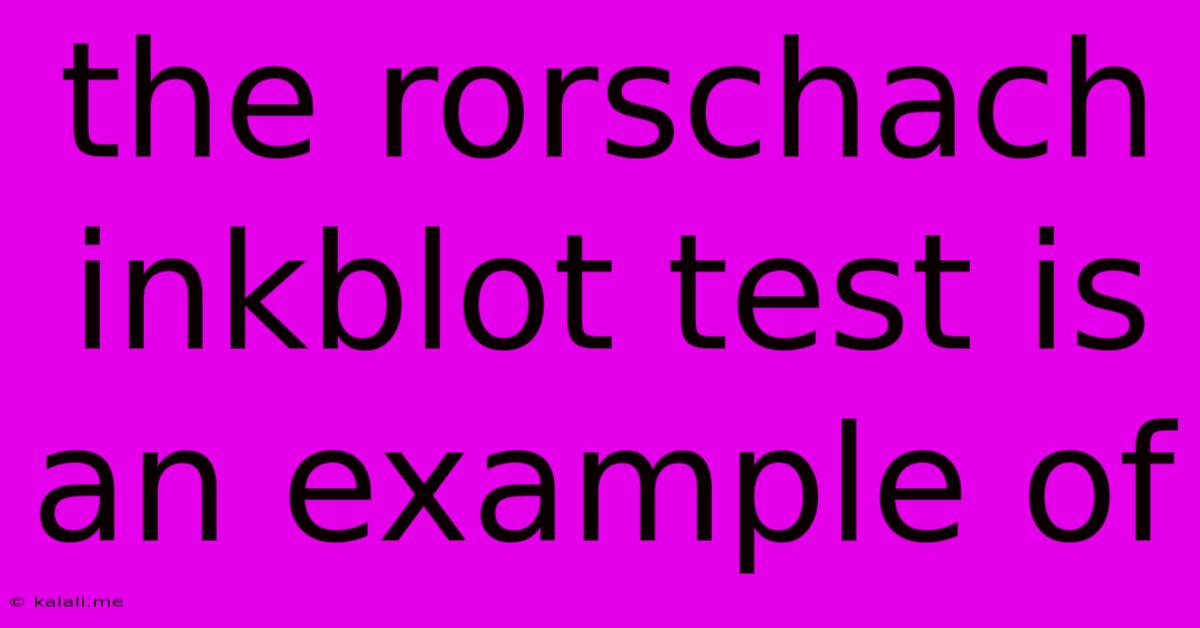The Rorschach Inkblot Test Is An Example Of
Kalali
Jun 16, 2025 · 3 min read

Table of Contents
The Rorschach Inkblot Test: An Example of Projective Testing and its Limitations
The Rorschach inkblot test is a classic example of a projective test. Projective tests are personality assessment tools that present ambiguous stimuli to individuals, encouraging them to project their unconscious thoughts, feelings, and motivations onto the stimuli. This allows psychologists to gain insights into a person's personality structure, underlying conflicts, and emotional state. While the Rorschach has a long history and continues to be used, it's crucial to understand its place within the broader context of psychological assessment and acknowledge its limitations.
Understanding Projective Techniques
The core principle behind projective techniques is that the individual's response to ambiguous stimuli reveals aspects of their personality that they might not consciously express. The Rorschach, with its ten inkblots, is a prime example of this. The test administrator presents each inkblot sequentially, asking the participant to describe what they see. The responses are then analyzed based on several factors including:
- Location: Which part of the inkblot did the individual focus on?
- Determinants: What aspects of the inkblot (shape, color, texture) influenced their response?
- Content: What specific objects or images did they see?
- Popularity: How common is the response amongst other test-takers?
Other examples of projective tests include the Thematic Apperception Test (TAT), which uses ambiguous images, and the Sentence Completion Test, where individuals finish incomplete sentences. These tests, like the Rorschach, aim to tap into unconscious processes.
The Rorschach's Strengths and Weaknesses
The Rorschach's proponents argue its strengths lie in its ability to:
- Uncover hidden conflicts and anxieties: By analyzing responses, clinicians might identify underlying emotional distress or repressed trauma.
- Assess personality structure: The test can potentially reveal patterns of thinking, coping mechanisms, and interpersonal styles.
- Supplement other assessment methods: The Rorschach can be used alongside other psychological tests and interviews to provide a more comprehensive picture of an individual's psychological state.
However, the Rorschach also faces significant criticisms:
- Lack of standardization and reliability: Different scoring systems exist, leading to inconsistencies in interpretation. The reliability (consistency of results over time and across different administrators) is a subject of ongoing debate.
- Subjectivity in interpretation: The analysis relies heavily on the clinician's judgment, potentially introducing bias.
- Cultural bias: The responses may be influenced by cultural background and experiences, affecting the validity of interpretations across different populations.
- Limited predictive validity: The Rorschach's ability to predict future behavior is questionable, limiting its clinical utility in certain situations.
The Rorschach in Modern Psychology
Despite its limitations, the Rorschach continues to be used in some clinical settings, often as part of a broader assessment battery. Its continued use often stems from its capacity to elicit rich qualitative data, potentially revealing nuances of personality not captured by more structured tests. However, it's crucial that clinicians using the Rorschach employ validated scoring systems, are aware of its limitations, and interpret the results cautiously. They should also consider the ethical implications of administering a test with such inherent subjectivity. The focus should always be on integrating the Rorschach findings with other clinical data to reach a comprehensive understanding of the individual.
In conclusion, while the Rorschach inkblot test serves as a significant example of projective testing, its application requires careful consideration of its strengths and, critically, its inherent limitations. Its use should be informed by rigorous methodology and ethical considerations, emphasizing its role as one tool among many in a comprehensive psychological assessment.
Latest Posts
Latest Posts
-
The Study Of The Earth Is Called
Jun 16, 2025
-
What Is The Least Common Multiple Of 26 And 39
Jun 16, 2025
-
Which Of The Following Is Chemical Change
Jun 16, 2025
-
Atoms Of The Same Element Having Different Numbers Of Neutrons
Jun 16, 2025
-
Displacement Thickness In Boundary Layer Formula
Jun 16, 2025
Related Post
Thank you for visiting our website which covers about The Rorschach Inkblot Test Is An Example Of . We hope the information provided has been useful to you. Feel free to contact us if you have any questions or need further assistance. See you next time and don't miss to bookmark.